Mladen and Del review ‘Project Power’
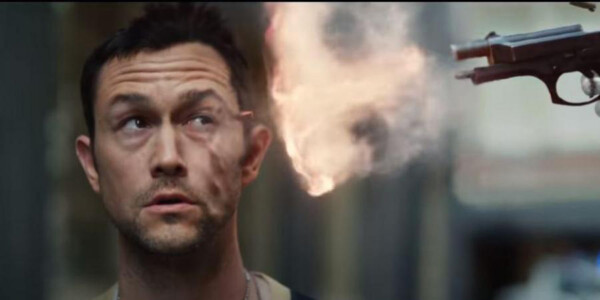
Image courtesy of Netflix.
“Project Power” Starring Jamie Foxx, Joseph Gordon-Levitt, Dominique Fishback, and others. Directed by Henry Joost and Ariel Schulman, 113 minutes. Rated R. Netflix.
Mladen’s take
I watched “Project Power” a couple of weeks ago and, because the film isn’t worth re-watching, I’m writing this review from memory. Don’t misunderstand, cantankerous Del. “Project Power” is fine for a one-time seeing. Its plot is decent. The acting is good. Visual effects are good. I appreciate the effort the directors made to convey some of the movie from an artsy perspective like the basement room brawl and shootout. Hell, there was one scene toward the end of the film that made me chuckle, though it was a take on the old, “No, your other left.” And, I don’t care that one of our protagonists melodramatized the strength of the strike of a mantis shrimp. Or, was it the pistol shrimp? Or, are they the same species of Odontodactylus?
In “Project Power,” a rogue defense contractor/pharmaceuticals company disallowed to trials test a powerful physiology-altering drug that either kills you or infuses you with a unique power starts selling it as street smack. To gather lessons learned, collect proof of its discovery’s potential to the rich and connected assholes of the world, and elude mainstream press coverage, the pharma moves from city to city using pre-screened drug dealers to push its wares. Where pharma’s potion draws coverage, it’s snippets reported by the local media. One such unbelievable story was the claim that a suspect outran a police car on foot. Toss in a father’s (portrayed by Jamie Foxx) search for his kidnapped daughter, a smart young woman’s (portrayed by Dominique Fishback) need to raise money to help her mother with medical bills, and a New Orleans cop’s (portrayed by Joseph Gordon-Levitt) urge to protect his city and “Project Power” becomes a movie with too many anecdotal, though tolerable, moments.
The principal trouble with “Project Power” is its blunt-force-trauma wokeness. Blending so forcibly and pedantically the prejudices faced by blacks into a sci-fi thriller, paradoxically, weakened the message all of us non-Trumpers, anti-McConnells, and Baby Gaetz-Jerkoff Jordan-Supplicant Nunnes haters want reinforced. Racism and lack of economic opportunity for blacks is disgraceful, immoral, and illegal, but you have to be careful about whining because it’ll trigger those among us who’ll happily respond to Black Lives Matter by flippantly saying all lives matter as though there’s no history of, oh, slavery and Jim Crow in this country. In “Project Power,” unfortunately, the wokeness takes the tone of a dry, set-piece lecture.
One of the film’s strongest points is the clever and authentic way it melded the story of “Henrietta” into its script. From the ACLU website: “In 1951, doctors harvested cells from Henrietta Lacks while she was receiving treatment for cervical cancer and discovered that her cells had an amazing capacity to reproduce. ‘The Immortal Life of Henrietta Lacks,’ which aired … on HBO and is based on the book of the same name, tells the dramatic story of how scientists used the ‘HeLa’ cells in research for decades without the knowledge of her family.” As it turns out, Foxx’s character in “Project Power” is chasing pharma because it kidnapped his daughter to study and weaponize her superpower to heal. Neat.
Fishback, who plays Robin in the film, is very good. She does a wonderful job creating her character, a spunky and smart high schooler caught in an untenable dilemma. To help her mother buy health care, Robin pushes pharma’s power pill to drug users. Foxx as Art goes smoothly from appearing to be a bad guy to showing himself as the good guy, after all. Frank, Gordon-Levitt’s role, is a smart-aleck cop who pops a power pill to don his special attribute, very tough skin and/or bones that can absorb a 9-mm round to the temple from pointblank range with only bruising. He just wants to save New Orleans from itself and grifters with links, if I recall correctly, to the federal government. That subplot got a little blurry for my aging brain. Wonder if there’s a pill for lapsing mental acuity?
“Project Power” is sprayed with violence, car chases, and such. All of it good. The CGI approached to top-notch, barring the flaming dude at the beginning of the movie. He looked like he was engulfed by flaming paper streamers or one of those eerie two-story-tall inflatable marketing tubes that bop and wave at you as you drive by. I can’t remember the score, suggesting it was unnoteworthy.
Shit, I don’t know. Maybe “Project Power” is worth a second viewing. I’ll think about it. You, meanwhile, feel free to enjoy this solid B of a movie for its fairly common sequences of good moviemaking. Del, how about you getting off your ass to see this film, so that we can satisfy our loving readers with yet another good review by me and whatever it is that you slap together?

Del’s take
Yes, Mladen, there is a pill for lapsing mental acuity. It’s called Prevagen and I gave you a bulk gift basket from Sam’s Club for Christmas last year. Or have you forgotten?
I watched “Project Power” because Netflix flogged it as “No. 1 in America,” the trailer had cool special effects and it starred Joseph Gordon-Levitt, of whom I am a big fan. I know. Those are judgments based on the book cover principle. But let’s not be coy: We all judge books by their covers, regardless of aphorisms and scolding admonitions. The “Project Power” looked cool.
I thought it was an OK movie. Not great; not terrible. An acceptable use of almost two hours of my entertainment ration. Gordon-Levitt and Foxx are excellent. Dominique Fishback is exceptional. The special effects were terrific and the script was airtight. Plus it was nice to see New Orleans as the setting; I’ve been there many times and it is a unique city, unlike any other in the country. In some ways it reminds me of Spain (a tactic urban planners could adopt for future American developments – cultural design).
I didn’t have as much a problem with the “wokeness” as Mladen put it, though I would agree the delivery of that important message was clumsy and heavy-handed. It leaned more toward telling, not showing, a cardinal sin for all storytellers.
My big problem with “Project Power” was this: They took a big idea and married it to a small story.
Imagine being able to take a pill that would give you a superpower for five minutes. Imagine the potential, not just for warfare but crime, sports, law enforcement, even entertainment? Imagine such a capability in the hands of a rogue player – North Korea, or a school shooter? With this technology you have the ability to completely revolutionize society, and in the process tell a big, world-spanning story. Instead, “Project Wastes” it on drug deals and a man trying to find his daughter. It’s like discovering a cure for cancer and using it to clear up those unsightly liver spots on your hands.
Also, was I mistaken or did the movie suggest taking this drug exacted a physical toll from the user? Because some of the folks looked a little worse for wear following their excursions into the world of superpowers. I don’t believe that aspect of the story was explored to any depth.
Believe it or not, Mladen, I agree with your grade of B for “Project Power.” It has big ambitions but wastes them on a small story that, in the end, doesn’t really change anything.
If you’re looking to invest two hours of movie-watching time in a gritty, science-fictiony universe, catch “Project Power” on Netflix. But unlike its magic pill, your mind will not have been expanded after the experience.
Mladen Rudman is a former journalist and technical writer. Del Stone Jr. is a former journalist and author.
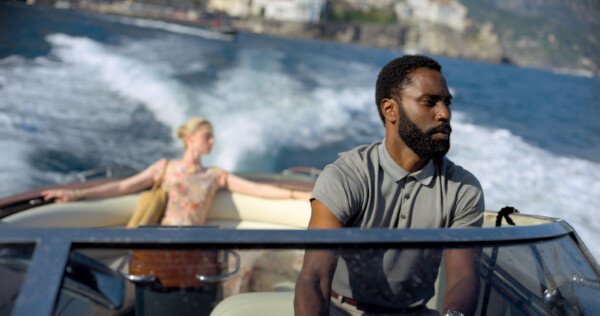
Image courtesy of Warner Bros.
“Tenet” Starring John David Washington, Robert Pattinson, Elizabeth Debicki, Aaron Taylor-Johnson, Kenneth Branagh, and others. Directed by Christopher Nolan. 150 minutes. PG-13. Pay-per-view on YouTube, Google Play, Amazon Prime, Vudu, DVD.
Del’s take
In my dodderage I’ve become less enamored of puzzle boxes, Russian dolls, hidden meanings, subtext within subtext, Rubik’s cubes and other gimmicks, tricks, deflections and distractions – anything capable of making me believe something that isn’t true. We live in an age Qanon, ignorance on an industrial scale, conspiracy theories, corporate subterfuge and red hat-wearing politicians who not only lie shamelessly but revel in their malevolent deceit. Is it asking too much of a movie to just be a freaking movie and entertain me for a couple of hours instead of making me do a bunch of work?
I spent $15.99 on the “Tenet” DVD and I really, really wish I could get that money back. “Tenet” is well made and several of the performances are excellent, but it’s unwatchably dense and about as warm as a guest at the county morgue.
I can’t effectively summarize the plot because I’m still not sure I understand it. John David Washington is a CIA agent who, after an attack at a Russian opera performance, is recruited into an effort called “Tenet.” (Did I mention none of the characters have names?) Tenet is a war between us and the future. We have doomed the future with climate change, and the future is not happy about it. Future scientists have invented a way to “invert” the entropy of people and objects, allowing them to travel backward in time. Instead of using this inversion nonsense to head off climate change, the future would track down a cache of plutonium pilfered from a Russian ICBM … for what purpose? We don’t know. Is plutonium what they’re really looking for? We don’t know. What’s this about “The Algorithm” – has Facebook also pissed off the future, or is The Algorithm some kind of world-ending secret weapon invented by a future scientist and hidden in the past? Well, we don’t know, but since they bring it up. …
It’s a migraine-inducing onion of riddles hidden within paradoxes layered with feints and false flags, and to be honest I found it exhausting and unrewarding.
What’s good about “Tenet” is the cinematography, the locations, costumes, and some of the performances. Washington is excellent as the CIA agent and in my book would make a fine replacement for Daniel Craig when all those catalogs for Medicare start showing up in his mailbox. Also excellent were Robert Pattinson as Washington’s sort-of partner and Elizabeth Debicki as the suffering wife of a wicked Russian oligarch who may or may not be trying to acquire The Algorithm for his own demented death-bed purpose.
What I did NOT like about “Tenet” was the blink-your-eyes-and-miss-critical-plot-points narrative, the mumbled and often indecipherable dialogue, the lack of any pathos (which is typical of Christopher Nolan’s fare) and the unfathomable density of the plot. It seems Nolan is making movies for himself, not his audience.
After everything that has happened the past four years, my brain is only capable of processing movies like “Hobo with a Shotgun” or “The Man Who Killed Hitler and then the Bigfoot.” I would need a few less pandemics, insurrections and climate catastrophes before I could enjoy “Tenet.”
If acting and cinematography were the only criteria I could give “Tenet” an A-. But its hard-to-hear dialogue, lack of an emotional heart and black-hole density bring that grade down to a B. If you’re up for doing the work Nolan seems to ask of his fans, knock yourself out. I wasn’t.
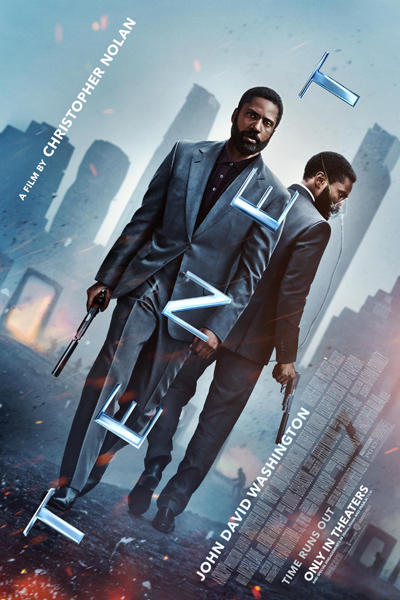
Mladen’s take
Alas, I share Del’s frustration with “Tenet.” Despite his dodderage and, believe me, it’s advanced, he’s correct about the film. “Tenet” is a mess in execution.
Actually, I’m more frustrated than Del because I disliked the suffering wife/doting mother character played by Elizabeth Debicki. She damn near caused the destruction of 7 billion people in our time because she didn’t want her one son to be traumatized by, oh, hell, I forgot the reason.
“Tenet” is based on a neat concept. In this nicely shot film, people are able to move backward or forward in the same space. The spacetime of “Tenet” (the word reads the same backward or forward) can be separated into space and time by scientists from the future, which, as Del notes, are waging war against the present by allying with, and supporting the martyrdom of, a Russian oligarch portrayed beautifully by Kenneth Branagh.
Demonstrating the usefulness of the capability to manipulate time – again, a neat concept – is badly mangled in “Tenet.” Particularly difficult to understand are the “temporal pincer movements” unfolding on the screen as opponents move along the time continuum in which every direction they thought would produce tactical advantage. So, for example, you have cars moving forward and backward in the same lanes. Or, you have one unit of troops starting, executing, and completing a mission and another completing, executing, and starting the same mission on the same battleground. Hell, in this film, a man can fight himself, one version of him being from the present and the other “inverted” or from where, the future? Now that I think about it, there might not be a present, past, and future in “Tenet.” In this film, time is jumbled and coils around itself, like a ball of yarn, rather than being a point-to-point, straight line event. Maybe.
The most annoying part of “Tenet” to me, for some reason, was the film insisting that an “inverted” bullet – that is, a bullet exiting your body in the same direction it had entered (I think) – would cause more damage than a bullet entering your body from the same direction it would exit. Wouldn’t a bullet reversing course and leaving your body return your body to its pre-bullet state? If the phenomenon is someone shooting you who’s inverted – while you’re what, verted? – why would there be damage at all?
I’m tempted to give “Tenet” some slack. The idea of time travelers moving in opposite directions while sharing the same space in a way that affects the outcome of the present and the future simultaneously is far out and wonderful. “Tenet” still has me thinking about time inversion, which is different, apparently, than merely time travel. “Tenet” also has some very good acting. And, I enjoyed the score. It was propulsive. My surround-sound AVR has a separate volume control for the center channel speaker, which broadcasts the dialogue in a film. I was able to listen to the words because I was able to turn-up their volume without also increasing the volume of the many explosions and much gunfire in “Tenet.” Del, I did hear the dialogue but it didn’t help me understand the movie any better.
Finally, “Tenet” was ripe for R-rated action. Yes, not showing graphically a man getting beaten to death with blows to the head using a gold bar is a terrific way of capturing violence. More is left to the imagination. But, much of the movie is loads of people shooting at each other or getting their asses mortar-ed. That would have benefitted from vivid blood splatter, heads disintegrating, and limb amputations. Making “Tenet” PG-13 was an error. This movie is not for teenagers nor will teenagers watch it. “Tenet” pushes toward cerebral. Teens ain’t interested in cerebral on the big screen. They want crude, sexual, and narcissistic, the kind of film one-term, poser president, loser Donald Trump would watch.
“Tenet” is a C because it promises top-notch sci-fi adventure and then fails to deliver.
Mladen Rudman is a former journalist and technical writer. Del Stone Jr. is a former journalist and author.
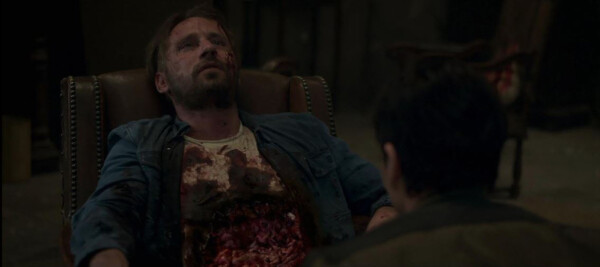
Image courtesy of Netflix.
“The Old Guard” Starring Charlize Theron, KiKi Layne, Matthais Schoenaerts, Marwan Kenzari, Luca Marinelli and Chiwetel Ejiofor. Directed by Gina Prince-Bythewood. Netflix. 125 minutes. Rated R.
Del’s take
I predict Mladen will love this movie.
He’ll give it 17 stars, an A to the nth power and at least one second watch, maybe two.
He’ll rhapsodize about the gore, the “Matrix”-esque firepower, the jaw-dislocating fight scenes, the insurance-adjusting destruction, and the fact that it stars Charlize Theron, who is developing quite the reputation as a badass rock ’em sock ’em fighter chick who can hang with The Road Warrior and now the semi-immortal do-gooders of “The Old Guard.”
And for once he won’t be wrong, for the most part, though I am going to skip the rant where he goes into the Dolby SurroundSound decibel whatevers.
“The Old Guard” is a Euro-sleek production that gives off more of a socially glib James Bond vibe than any “Atomic Blonde” or “Salt.” These globe-trotting polyglot martial artists who can strangle a mercenary wearing body armor while parsing a slab of baklava with their taste buds might just be the new thing, if Netflix plays its cards right, and clearly it intends to try – the movie is set up as Entry No. 1 of a franchise.
The story is based on the Greg Rucka-Leandro Fernandez comic book from Image: Some people, like Rob Lowe, are born with an inability to die. Shoot ’em, stab ’em, toss ’em in front of a Freightliner and a minute later they pick themselves up, dust off the tire tracks and carry on, their hair slightly out of place. The band of immortals in “The Old Guard” has taken crime-fighting as its joie de vivre. At least they’re not running for office.
After thousands of years the immortals have, shall we say, developed a fighting skills set second to none. Even if they weren’t immune to your bullets, they could stomp your ass with ease. And that’s what this movie is about – stomping ass, in this case an evil big pharma company (is “evil” redundant when coupled with “big pharma”?) that wants the secret to their longevity.
It all works, and it works well. I had no problem with suspension of belief, and that’s something I struggle with every single time I watch a superhero movie. Acting was spot-on, although Harry Melling’s Merrick, the big pharma chieftain, drifted into the fringes of self-caricature. Pacing was brisk with the occasional infodump that lowered the octane of carnage, and the characters were well-developed, spoke intelligent (sometimes funny) lines and otherwise provided a level of empathy that rendered them as human beings, not comic book cannon fodder.
The quality of Netflix movies is improving to the point the streaming service is as legitimate a moviemaker as any brick-and-mortar studio. “Bird Box,” “Extraction” and now “The Old Guard” are entertaining movies available to anybody with a subscription. You must, however, provide your own buttered popcorn.
The movie is rated R, which should salve Mladen’s fragile, French soap-scented movie-watching ego, and it comes with enough shell casings to earn you a profitable trip to a dopamine addiction treatment facility.
I give it an A-.
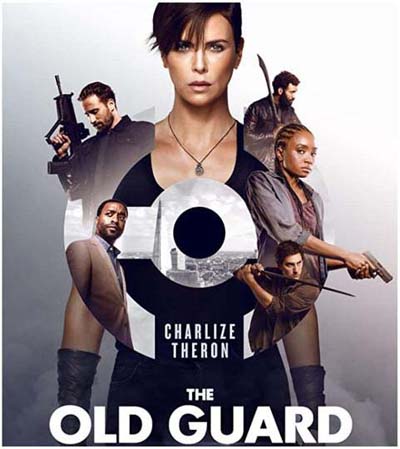
Mladen’s take
I’d disagree with Del’s prediction about me “loving” this film, but I don’t want to hurt his fragile feelings.
“The Old Guard” is solid action fare based on the principle that immortality has an expiration date. An A-, though? I think not. Let’s go with a straight-up B and the recommendation that you see this film. And, as an aside, Del’s description of Charlize Theron should’ve included “really good-looking,” maybe before “badass.”
The justification for the B is that there are moments when the movie slides toward morose. It’s Theron’s fault. She portrays the character Andy. Old Guard leader Andy is wracked by the obvious, which should’ve been even more obvious to her because she’s, like, hundreds of years old. You see, Andy, now a 21st century denizen has started asking the question, “Is mankind worth saving?” Sheesh, Mankind has been unworthy of existing since we descended from the trees and started walking the plains.
So, the strategic problem with “The Old Guard” is that it needed justification for the mercenary ways of the troop of semi-immortals, recently joined by KiKi Layne’s Nile. That justification, alluded to above, is banal: the Guard sprays limited-spectrum helpfulness adjuvanted with the hope that humanity deserves salvation despite the overwhelming fratricide it practices day in, day out. The Guard exists to fumigate dickheads modeled on assholes such as Bashar al-Assad and Donald Moron Trump, but is sidetracked by the amoral Big Pharma nerd mentioned by Del. The nerd reminded me of real-life “Pharma Bro.” Remember Martin Shkreli? He raised the price of an antiparasite drug 5,000 percent. Who tends to suffer from parasitic infections, say, malaria? Uh huh, the poor. Did upping the price of Daraprim make it more affordable for them or the nonprofits helping them? No. But, would have whacking Shkreli made a difference for mankind? No, because along came another Big Pharma executive, this one female, to hyperinflate the price of antihistamine auto injectors, i.e., the life-saving product known generically as an “epi-pen.”
I agree with my fellow co-reviewer. The characters in The Old Guard are nicely developed. They have on-air chemistry. They’re the socially acceptable mix of female and male, heterosexual and homosexual, and race. There’s a neat ambiguous betrayal, too. At the end of the movie in preparation for The Old Guard Chapter Two, an important-to-be partial-immortal of Asian ethnicity is introduced. Her entrance is laced with portent.
Also pluses are the film’s allusions to real-world grotesqueness: the use of chemical weapons on luckless people, the kidnapping of children by fundamentalists, and the aforementioned Big Pharma sleaziness. The movie’s locales are stark such as desert or claustrophobic such as heavy urbanization. The Guard moves about by bartering deals with lower-level scumbags. Hey, you gotta do what you gotta do to get to the higher-level scumbags.
And, yes, there’s the violence. It’s a nice mix of hand-to-hand, blade, and bullet peppered with an occasional explosion. The more speakers you’re AVR is driving during the film, the better.
From a production standpoint, “The Old Guard” clearly demonstrates the way streaming has changed moviemaking. Films have become a global enterprise. One wonders who’s financing them. I hope that by enjoying “The Old Guard” I didn’t indirectly make Putin, Xi, or the petty tyrants running places like Singapore or East Europe richer. Who knows? Maybe Putin or Xi knockoffs are on the list of muthers who are eradicated by our band of benevolent PMCs in the next film of the now nicely rooted franchise.
Mladen Rudman is a former journalist and technical writer. Del Stone Jr. is a former journalist and author.
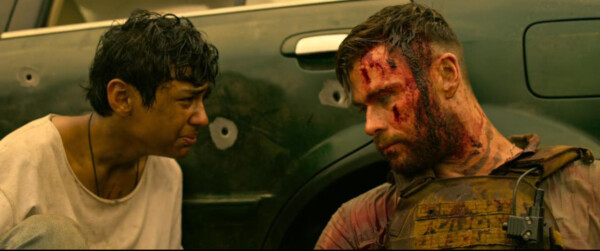
Image courtesy of Netflix.
“Extraction” Starring Chris Hemsworth, Bryon Lerum, Ryder Lerum, Rudhraksh Jaiswal, Shivam Vichare, Randeep Hooda, David Harbour, and others. Directed by Sam Hargrave. 116 minutes. Rated R. Netflix.
Mladen’s take
Think of “Extraction” as a John Wick movie with two John Wicks. The film is as good as “John Wick Chapter 3,” which was less good than “John Wick Chapter 2,” which was less good than “John Wick Chapter 1,” a delightful action blockbuster and the Gold Standard for depicting personal violence on the big screen. “Extraction” is worth seeing. It’s closer to a B+ than an A-. And, don’t confuse this “Extraction” with the “Extraction” starring Bruce Willis. Apparently, the Willis film is the opposite of good.
Hemsworth’s character Tyler is a PMC with a guilty conscience. It’s the guilt that yields some banal chatter between him and his teenaged ward and even, get this, tears. The emotional putridness is what pushes this hostage rescue movie into the upper B range. Hell, I expect touchy feely Del to condemn me for my dislike of the effort to introduce warmth to the movie. So, Del, let me be clear. I find it more endearing that Wick whacked a bunch of people for killing his dog and stealing his classic Ford Mustang than Tyler’s decision to save a privileged youth who lives in a society built on unimaginable inequities. The income gap, houselessness, and medical insurancelessness in America ain’t nothing juxtaposed to what upper caste Indians do to lower caste Indians.
The action, violence, and tension in “Extraction” are a whole ’nother story. Give that subset of the film a sparkling A.
On this side, we have Tyler and his Australian army commando good looks and pumped body and, on the other, Saju, portrayed wonderfully by Randeep Hooda. Tyler and Saju, a former Indian army commando with flowing long, dark hair and chiseled jaw, are initially foes and ally later in the movie to execute the good deed. They are the muscular playthings of a feud between an Indian drug boss and a Bangladeshi drug boss. Much of the action takes place in Dhakka.
The fight sequences of the two Wick mimickers against each other and corrupt Bangladeshi army troops are top-notch choreography. There’s hand-to-hand. There are close-in pistol shots to heads and thoraxes. Thoraxi? Thoraxae? There are assault rifle gun-downs at medium range. And, there are exploding heads via snipers at long distances. Damn fine Wick-y-ness. But, though I hate to admit this, there is one prolonged gun battle toward the middle of the movie that ran too long. It was reminiscent of a battle sequence in “Battle LA” that also held children in peril for an interminable period.
Tyler and Saju absorb wicked abuse. It’s the sort of abuse that none of the other shooters in the movie could take. The PMCs recover faster from lacerations, contusions, and blood loss than Donald Moron Trump and William Stay Puft Barr violate the U.S. Constitution. The good part? There’s no effort to explain Tyler’s and Saju’s resilience by pointing out that they are forces of pure will. The two are well-conditioned dudes with a single goal driven, ultimately, by self‑interest. Plausible.
It would be a mistake to ignore the potent character played by David Harbour, as brief as his appearance in “Extraction” is. Harbour portrays another PMC and is Tyler’s long-time buddy. Slimmed down from his days as the sheriff in “Stranger Things” and imposing, Harbour is terrific as the merciless, though he argued otherwise, mercenary. He almost persuaded me to back doing what he wanted to do. Remarkable. Ten million dollars is a lot of money, after all.
“Extraction” also benefits from a very good original score by Henry Jackman. Its tone fits the film. The score’s moodiness, modernity, despair, and a touch of “everything-will-be-all-right” move the movie by helping pace it and adding atmosphere. Maybe this also means that streaming services are now starting to attract capable composers. What would “Jaws” or “Star Wars” be without John Williams? “The Good, The Bad, and The Ugly” or “The Thing” without Ennio Morricone? Almost nothing, I argue. To me, the sound in a movie, including its score, is more important than the visuals. That means what? Yep, to enjoy “Extraction” correctly you need an AVR pushing as many speakers as possible at decibels that will annoy your neighbors up and down the block.
Finally, yes, the ending of “Extraction” set up a sequel. Who was that stranger standing poolside?
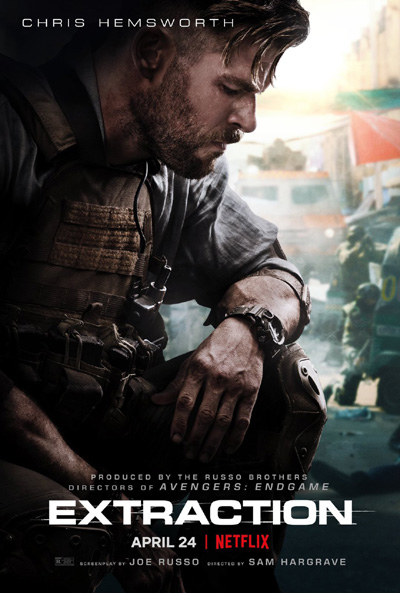
Del’s take
I expect to visit Mladen one day and find him sunning on a rock with the lizards that make up his band of cold-blooded brothers. He might flick his tongue to catch a fly, then bask in exothermic bliss as he digests his snack, untroubled by emotion or feelings, a Mr. Spock among iguanas.
But enough hissing.
I thought “Extraction” was a much better movie than Mladen’s fussy take and I’m surprised he went in that direction. The movie is a bloodbath that by comparison reduces John Wick to a milquetoast Mr. Rogers guest starring on a Richard Simmons workout video. I was black and blue from just watching it. Sure, Hemsworth gets choked up when remembering the death of his little boy. Who wouldn’t? It was 30 seconds of characterization that lifted Hemsworth from the realm of Van Dammit and Rambot into the arms of relatable human beings. I don’t mind seeing my heroes bleed.
The story is simple: The 14-year-old son of a jailed drug lord is kidnapped by a rival cartel chieftain. The boy’s father is understandably pissed and tells the boy’s chagrined guardian to get him back, or else. You’ve probably watched enough episodes of “Narcos” to know what “or else” means in drug lord-speak. Problem is, the government has frozen the drug lord’s assets, so there’s no money to hire the army necessary to free the boy.
The solution? Hire Thor.
And that’s it. Get the kid back. A hammerless Chris Hemsworth swings into bloody action, laying waste to corrupt Bangladeshi soldiers, hired triggermen, a band of rotten brats sprung from the imagination of a methed-out Charles Dickens, and even a former pal who wants to retire but lacks the necessary funds … until now.
The mayhem is fast and very, very furious with lots of shooting, beatings, car chases, stabbings, and even one scene where Hemsworth pummels a guy into a senseless stupor with a stove pot. It makes a delightful clonky sound and I couldn’t tell if it was coming from the pot or the guy’s head.
Hemsworth’s character, Tyler, is motivated to go above and beyond by the memory of his child. When the boy was diagnosed with a terminal illness, Tyler chose another tour of duty in Afghanistan over remaining stateside to preside over the boy’s decline and eventual death. His wife left him over that – deservedly so. And now he must atone for that sin of abandonment by not abandoning another child in need. Yes, his teenaged ward is the son of a drug lord, as Mladen pointed out. But he’s 14, for Christ’s sake. He hasn’t made any of his life’s choices, except which PornHub channel to bookmark. You can’t blame him for his father’s poor choices.
The movie was well-done in many ways, from the setting to the script and even Hemsworth’s performance, which was not overbaked and in some ways contained surprising and, dare I say it, heartwarming subtleties.
So the movie worked for me and I’m rating it a solid A. The only thing that could top it would be a movie that paired Hemsworth with immortal Charlize Theron to kick Godzilla’s ass. Take THAT, Mladen!
You want action without caricature? You want “Extraction.”
Mladen Rudman is a former journalist and technical writer. Del Stone Jr. is a former journalist and writer.

Image courtesy of Sony Pictures.
“Sputnik” Starring Oksana Akinshina, Fyodor Bondarchuk, Pyotr Fyodorov, Anton Vasiliev and others. Directed by Egor Abramenko. Music by Oleg Karpachev. 113 minutes. Amazon Prime. Should be rated R for at least gore.
Mladen’s take
If the commie pinko fascist reds of the Putin regime savaging Russia today ever build an economy and arsenal like a few of that luckless nation’s citizens built the film “Sputnik,” the U.S. is in trouble. “Sputnik” is Grade A sci-fi horror nicely balanced with the correct doses of well acted storytelling, a world class score, and sophisticated, non-overbearing CGI. The movie is in Russian, so it’s captioned. Inevitably, something must’ve been lost in translation to English, but don’t let that discourage you from seeing the film. The captioning is good enough to convey its neat ideas and the character of the characters.
The Soviet Union is only seven years from disintegrating when this movie takes place. It’s 1983. It’s still the first Cold War. And, the Politburo needs a nationalistic win to boost the country’s sagging morale. The U.S.S.R. war in Afghanistan ain’t going well. Consumer goods are in short supply, unless you’re privileged. The Communist Party is going through leaders like Donald Moron Trump goes through unqualified cabinet secretaries. So, the addled Soviet Union turns to one of its few semi successes, space travel, for a taste of accomplishment. Two of its cosmonauts go into low-earth orbit, but three passengers return.
What unfolds next will have movie reviewers inevitably drawing comparisons between “Sputnik” and one of the two greatest sci-fi horror films ever, “Alien.” Labeling “Sputnik” an “Alien” derivative would be a false equivalency, however. It’d be like bashing “Alien” for mimicking “Invasion of the Body Snatchers.” There’s nothing new in moviedom about films creature featuring critters living inside us. “Invasion” with Donald Sutherland is a terrific movie, as is “Alien” with Sigourney Weaver. In “Sputnik,” Oksana Akinshina is top notch as her character, neuropsychiatrist Tatyana Klimova. Amiably menacing Fyodor Bondarchuk as Colonel Semiradov, charming survivor cosmonaut Konstantin Veshnyakov played by Pyotr Fyodorov, and Anton Vasiliev donning the role of ambitious but riven Dr. Yan Rigel are excellent, too. Even the movie’s title is well executed. “Sputnik” means “fellow traveler” or “companion,” but, generally, in a friendly way. That’s not what we get here.
“Sputnik” is one of the finest sci-fi movies I’ve seen in years. It’s better than “Life,” “Annihilation,” “High Life” or “Ad Astra.” It approaches “Europa Report” and “Arrival” in quality in terms of applying science to decipher what’s occurring, as well as acting and atmosphere. As with “Arrival,” for example, there’s a strong and intelligent female as the principal player in “Sputnik.” There’s tension and a twist or two as the characters develop. There’s realism. In “Arrival” the militaries of the world take the lead in trying to understand the aliens that have parked ships above certain spots on Earth. In “Sputnik,” the Soviet army’s Semiradov is trying to weaponize the trilling, cute-ish, slimy symbiont emerging nightly from the esophagus of Veshnyakov to feed. Pay attention to that part, the feeding. The food the alien needs is produced by a human’s endocrine subsystem. The way the creature ensures that happens is one of the movie’s provocative and original ideas. Loved it.
Come to think of it, there’s one other parallel between “Arrival” and “Sputnik.” This one falls into the category of irritating with a caveat. Both films have annoying time spanning flashes that involve children. Where that was needed to tell the story in “Arrival,” it was not needed to tell the story in “Sputnik.” But, that’s a minor quibble.
Disregard Del’s take, if he even suggests in his introduction that the film stinks. To dislike “Sputnik” is to demonstrate short-circuited sensory response, poor reasoning, a flawed recollection of movie history, moral turpitude and full-on soullessness. Watch “Sputnik.” It’s so good that I’m hoping to buy the film on Blu-ray. This way, when some National Security Agency trained, white hat hacker blows up the internet in anger after losing his Luke Skywalker figurine still in the original package that he put up as collateral to speculate on cryptocurrency futures, I’ll be able to watch this film again and again without worrying about access to a streaming service.
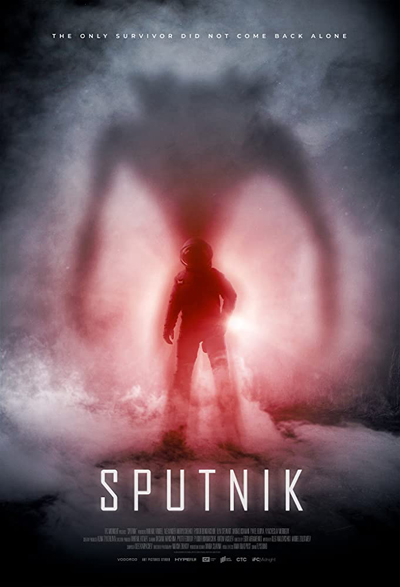
Del’s take
Man, what a stinker!
(I am picturing Mladen frothing at the mouth, his eyes goggling out like one of those squishy rubber chickens.)
On second thought, mark your calendars, folks, because today is one of those rare occasions – snow falling on Labor Day, the Florida unemployment compensation site actually working – when Mladen and I agree on something. “Sputnik” is a splendid film, the kind once made in America before the MBAs took over Hollywood.
“Sputnik” is a period piece, set in that happy time frame – for the United States, anyway – of the 1980s when MTV played music videos, imported beer became all the rage and many of us had waistline measurements that did not begin with the number 4. Except in “Sputnik” we are mired in the drab, run-down Soviet Union where people seem drab and run-down themselves, perhaps wearied by the relentless and dispiriting reality of communism. Neuropsychiatrist Tatyana Klimova, who has lost her job because of her unorthodox methods, has been summoned to a remote military facility to examine one of two recently returned cosmonauts – the other is deceased – who is experiencing amnesia. Except there’s a complication and I like the way Mladen put it: “Two of its cosmonauts go into low-earth orbit, but three passengers return.”
That’s a creepy premise and the movie delivers on creep, offering start-to-finish tension that lets up only briefly to set the stage of an original and surprising finish, one I’m surprised Mladen didn’t crab about seeing as how it’s laden with sentimentality.
Mladen is right. “Sputnik” has drawn comparisons to “Alien,” but the world of fiction, be it print or moving picture, provides a surfeit of tales about small groups confined to small spaces facing a singular threat – the Agatha Christie novel “And Then There Were None,” the lighthouse couple in “Day of the Triffids,” and even the happy gang of “The Walking Dead” to name a few. “Sputnik” may tread familiar ground but it strikes its own path.
It is no coincidence a movie about a man afflicted with a destructive internal force and the woman determined to save him takes place in a creaky totalitarian regime that is rotting from the inside, and Americans should pay heed to the cautionary aspects of the movie, which equally reflect the intellectual and moral rot eating the heart out of this country. That comment may not sit well with the Sieg Heil crowd that seems to be running Washington these days, but you know what? They’ll get over it.
The Russians and Chinese are improving their movie-making skills – “Winter of the Dead” and “The Wandering Earth” are two examples – and “Sputnik” continues that trend. I don’t draw any political conclusions from this fact – I think the improvements have come in spite of their no-fun, no-inspiration political and economic systems. Like Klimova of “Sputnik,” some moviemakers in those repressed states have risen above their hopeless surroundings to find some measure of success. Let’s hope that trend is just the beginning.
I give “Sputnik” an A.
There, Comrade Mladen. Are you happy now?
Mladen Rudman is a former journalist and technical writer. Del Stone Jr. is a former journalist and author.

Recently I posted a link to a story about former Republican Congressman Aaron Schock, who finally admitted he is gay. Schock was known for opposing gay rights measures while in office.
In my post I said something to the effect that from now on, I would assume any Republican opposing gay rights is secretly closeted.
The post received a number of responses, some of them depressingly predictable in their defense of the GOP. So to clarify:
Do I believe each and every Republican lawmaker who opposes gay rights is secretly closeted?
Of course not!
That was a literary device, written for dramatic effect. Not every Republican lawmaker who opposes gay rights is secretly closeted, but some are, and they are being caught in homosexual trysts, which makes them liars and hypocrites.
I became curious about some of the examples and compiled this list. Bear in mind it’s only a PARTIAL list. I could have added more names:
Republican Bob Allen: Opposed LGBTQ rights, caught offering a male undercover officer $20 to perform oral sex on him.
New Progressive (derived from the Republican Party) Robert Arango: Opposed LGBTQ rights, caught posing shirtless on the gay sex solicitation app Grindr, resigned in shame.
Republican Roy Ashburn: Opposed LGBTQ rights (and blamed that on his constituents), arrested for DUI after partying at a gay nightclub. Admitted later he is gay.
Republican Bruce Barclay: Opposed LGBTQ rights, caught hiring gay prostitutes and shooting videos of the sexual encounters.
Republican Robert Bauman: Opposed LGBTQ rights, caught soliciting sex from a 16-year-old male prostitute.
Republican Randy Boehning: Opposed LGBTQ rights (and blamed that on his constituents), caught sending racy photos to a 21-year-old male on the gay sex solicitation app Grindr.
Republican Larry Craig: Opposed LGBTQ rights, caught asking a male undercover agent for sex in a Minnesota airport men’s room.
Republican Richard Curtis: Opposed LGBTQ rights, caught paying a young man for sex and dressing in women’s clothes.
Republican David Dreier: Opposed LGBTQ rights, discovered to be living with his “partner,” another man.
Republican Mark Foley: Caught soliciting teenage congressional pages, disgraced.
Republican Phil Hinkle: Opposed LGBTQ rights, caught offering an 18-year-old male $140 for “a really good time.”
Republican Jon Hinson: Denied he was gay, married, caught performing oral sex on a man in a Washington, D.C. men’s room.
Republican Troy King: Opposed LGBTQ rights, caught by his wife in bed with another man.
Republican Jim McRery: Opposed LGBTQ rights, accused of using his college fraternity as a front for gay activity.
Republican Glen Murphy Jr.: Opposed LGBTQ rights, caught performing oral sex on a 22-year-old sleeping man.
Republican Aaron Schock: Opposed LGBTQ rights, caught taking a shower with another man, admits on social media he is gay.
Republican Edward L. Schrock: Opposed LGBTQ rights, caught leaving messages on a gay sex line, did not seek re-election.
About the author:
Del Stone Jr. is a professional fiction writer. He is known primarily for his work in the contemporary dark fiction field, but has also published science fiction and contemporary fantasy. Stone’s stories, poetry and scripts have appeared in publications such as Amazing Stories, Eldritch Tales, and Bantam-Spectra’s Full Spectrum. His short fiction has been published in The Year’s Best Horror Stories XXII; Alfred Hitchcock’s Mystery Magazine; the Pocket Books anthology More Phobias; the Barnes & Noble anthologies 100 Wicked Little Witch Stories, Horrors! 365 Scary Stories, and 100 Astounding Little Alien Stories; the HWA anthology Psychos; and other short fiction venues, like Blood Muse, Live Without a Net, Zombiesque and Sex Macabre. Stone’s comic book debut was in the Clive Barker series of books, Hellraiser, published by Marvel/Epic and reprinted in The Best of Hellraiser anthology. He has also published stories in Penthouse Comix, and worked with artist Dave Dorman on many projects, including the illustrated novella “Roadkill,” a short story for the Andrew Vachss anthology Underground from Dark Horse, an ashcan titled “December” for Hero Illustrated, and several of Dorman’s Wasted Lands novellas and comics, such as Rail from Image and “The Uninvited.” Stone’s novel, Dead Heat, won the 1996 International Horror Guild’s award for best first novel and was a runner-up for the Bram Stoker Award. Stone has also been a finalist for the IHG award for short fiction, the British Fantasy Award for best novella, and a semifinalist for the Nebula and Writers of the Future awards. His stories have appeared in anthologies that have won the Bram Stoker Award and the World Fantasy Award. Two of his works were optioned for film, the novella “Black Tide” and short story “Crisis Line.”
Stone recently retired after a 41-year career in journalism. He won numerous awards for his work, and in 1986 was named Florida’s best columnist in his circulation division by the Florida Society of Newspaper Editors. In 2001 he received an honorable mention from the National Lesbian and Gay Journalists Association for his essay “When Freedom of Speech Ends” and in 2003 he was voted Best of the Best in the category of columnists by Emerald Coast Magazine. He participated in book signings and awareness campaigns, and was a guest on local television and radio programs.
As an addendum, Stone is single, kills tomatoes and morning glories with ruthless efficiency, once tied the stem of a cocktail cherry in a knot with his tongue, and carries a permanent scar on his chest after having been shot with a paintball gun. He’s in his 60s as of this writing but doesn’t look a day over 94.
Contact Del at [email protected]. He is also on Facebook, twitter, Pinterest, tumblr, TikTok, Ello and Instagram. Visit his website at delstonejr.com .

Image courtesy of Saban Films and Mega Agency.
“Guns Akimbo” Starring Daniel Radcliffe, Samara Weaving, Ned Dennehy. Directed by Jason Lei Howden. 1 hour, 28 minutes. Rated R. Amazon Prime.
Mladen’s take
“Guns Akimbo” is largely a crappy movie, but I’m giving it an A. Here’s the sole reason by analog. The movie works with the premise that the internet is the equivalent of a blowjob by a mouth with acid saliva and fangs dripping neurotoxins. To stretch the analog, the blowjob will feel good for the first few seconds because the recipient hasn’t yet realized that he’s about to lose his member. That’s the internet for you. Ooh, Facebook is so neat. Look, I can share pictures of me and my family with anyone and that anyone turns out to be a scammer, pedophile or Putin bot telling you to join Proud Boys or Oath Keepers to make the world safe for democracy.
Yes, Del, I’m getting to the summary.
Miles (played by Harry Potter) is a loser coder who online insults a Dark Web show called Schizm – think first-person shooter with the shooters and their victims real persons. Offended Schizm creator Riktor (Ned Dennehy) and his goons kidnap Miles and surgically attach a pistol, one for each hand, to him with nuts and bolts and nails. For Miles to get de-pistoled or save his somewhat ex-girlfriend from Riktor and his sadistic clan of internetters or whatever, he has to whack Schizm’s reigning champion, Nix (Samara Weaving). Violent hijinks unfold with Miles at one point ranting into web-connected cameras that all this death and mayhem and cruelty and voyeurism happens because people keep watching it. The death and mayhem and cruelty and voyeurism are all your fault, Miles yells. The Schizm fans responded with a “Fuck you.” Maybe they knew Miles was one of them before he became a pawn in the non-virtual aspect of the web show, real death.
One way of describing “Guns Akimbo” (2019) is by noting it’s “The Truman Show” (1998) with a lot of cussing, blood splatter, casings ejected from receivers, and explosions. But, where Truman is funny and charming throughout, “Guns” doesn’t get funny or charming until Miles and Nix ally to destroy Riktor. Regrettably, that comes toward the end of the film.
Mostly, “Guns” is dour without achieving sardonic, which I believe was one of the director’s goals. Along with reminding me of “Truman,” “Guns” is tinged with “Judge Dredd” (2012) and “Sin City” (2005). Another seeming influence? Possibly, “Shoot ’Em Up” (2007), an underrated, though equally demented, movie.
“Guns”’ production quality is good, though the blood splatter looked like blobs of red gel departing plastic containers rather than liquid forced from skulls disrupted by high velocity projectiles. The film’s score matches its frenetic violence. The soundtrack is good, too. It’s a combination of classic rock-disco-pop (e.g. “Super Freak,” “You Spin Me Round”) and newer stuff. I added “When the Shit Goes Down” to my “It Ain’t No Use” playlist.
See “Guns Akimbo” because its heart is in the right place. The film states plainly that the internet is dangerous because we humans have no self-control.
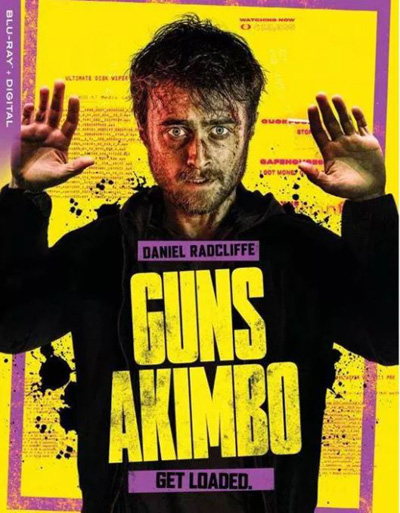
Del’s take
Your potty mouth is showing, Mladen. No more R-rated movies for you.
As for “Guns Akimbo,” my impression is this: It’s a bloodier, filthier, funnier version of “Horns.”
I have finally trained Mladen, after years of shaming, to summarize the plots of movies we review so you know what “Guns Akimbo” is about. Suffice it to say if you have seen “Horns” you will appreciate a couple of things:
1. Daniel Radlcliffe seems hellbent on pursuing quirky, offbeat roles that will define him as a young turk.
2. “Guns” aspires to be as quirky and offbeat as Radcliffe’s aspirations but falls short of the mark.
As comedy it’s hilarious. The characters are hilarious as caricatures of stereotypes, if you choose to view them that way. The script is hilarious. Even the sight gags are hilarious – picture hapless Radcliffe fleeing the bad guys with pistols bolted to his hands, his bunny slippers flopping and his bathrobe flapping. I thought it was funny, the way a 12-year-old boy – and some retired journalists – find accidental farts to be funny.
As commentary it’s a shallow swoop as it becomes the very thing it criticizes, and I doubt director Howden meant that as a meta critique. The message of “Guns” is that the internet sucks and it’s letting our inner assholes off the leash. Well, yeah, tell me something I didn’t know.
Is “Guns” entertaining? Oh sure. I watched it start to finish, which is unusual for me. These days I’m usually nodding off then jerking away to find drool running down my chin long before Jimmy Fallon hits the air. But is “Guns” sophisticated storytelling? Nah, not that it tries to be. Howden seems content to produce a flavor of the moment and “Guns” will not have the staying power of, say, Cool Ranch Doritos.
Mladen soft-pedaled the violence. Sure, it was presented in the larger guise of humor, but Jesus Christ it was violent. I’m at a loss as to how Mladen can fuss about a single violent scene in “The Hunter” and laugh off the relentless torture and bloodshed of “Guns Akimbo.”
I don’t like casual cruelty because (a) it’s not entertaining, (b) it’s immoral and uncivilized, and (c) it desensitizes the viewer to real violence. That’s my theory. I’m sticking to it despite the grief all those “Fuck you” viewers may give me.
Mladen must have channeled his inner Antifa Bake Sale chairman to give “Guns Akimbo” an A rating. No, folks, it’s not an A. It’s clever. Production values are good. Acting is admirable. But it’s bloody and violent. There’s nothing new about its message. And 10 years from now it will be nine years past its shelf life.
I give it a B-.
Mladen Rudman is a former journalist and technical writer. Del Stone Jr. is a former journalist and author.

Image courtesy of Flickr user Gage Skidmore by way of a Creative Commons search. https://www.flickr.com/people/22007612@N05
I’m not sure what to make of the Iowa caucus results.
I’m not even sure the results are valid. After the difficulties the Iowa Democratic Party experienced with the vote-counting app – apparently nobody had the foresight to sufficiently train users and test the software prior to Feb. 3 – we may never know who actually won.
The current result is Pete Buttigieg, who barely edged Bernie Sanders for the lead. I know that among Democratic frontrunners, Buttigieg and Biden are the most moderate, which gives me a bit more peace of mind. Folks like Sanders and Elizabeth Warren would, in my opinion, wreck the economy. The kids who support Free Everything are well-meaning but callow when it comes to understanding the brass-tacks functionality of our way of life.
Obviously many people like Donald Trump, which means if the Democrats want to win in November they must nominate somebody whose reach is even greater, which leads me to ask:
Can an openly gay man win the presidency?
For sure, America has made progress on this issue. In the past, being gay would have meant instant disqualification for any presidential candidate. Now, a gay candidate has won a state primary.
But is America ready to vote for a guy who would bring a First Husband to the White House? Who would be seen in news photos and on TV kissing a man?
Considering the recent uproar over the dissolution of “Don’t Ask, Don’t Tell,” and the Supreme Court confirmation of gay marriage, I don’t see church-going, blue collar America supporting a gay candidate, man or woman.
Let’s face it: There’s still a lot of intolerance out there, and when it comes to gay men, there’s a LOT of intolerance. I don’t think Americans would follow a Pete Buttigieg. More would than before, but not enough – certainly not enough to beat Trump.
If Buttigieg continues to win primaries he will lay the groundwork for a day when a gay candidate, male or female, CAN win the presidency.
But I don’t think that day is now. I think people will vote with what they’ve been taught, and right now that means four more years of Trump.
About the author:
Del Stone Jr. is a professional fiction writer. He is known primarily for his work in the contemporary dark fiction field, but has also published science fiction and contemporary fantasy. Stone’s stories, poetry and scripts have appeared in publications such as Amazing Stories, Eldritch Tales, and Bantam-Spectra’s Full Spectrum. His short fiction has been published in The Year’s Best Horror Stories XXII; Alfred Hitchcock’s Mystery Magazine; the Pocket Books anthology More Phobias; the Barnes & Noble anthologies 100 Wicked Little Witch Stories, Horrors! 365 Scary Stories, and 100 Astounding Little Alien Stories; the HWA anthology Psychos; and other short fiction venues, like Blood Muse, Live Without a Net, Zombiesque and Sex Macabre. Stone’s comic book debut was in the Clive Barker series of books, Hellraiser, published by Marvel/Epic and reprinted in The Best of Hellraiser anthology. He has also published stories in Penthouse Comix, and worked with artist Dave Dorman on many projects, including the illustrated novella “Roadkill,” a short story for the Andrew Vachss anthology Underground from Dark Horse, an ashcan titled “December” for Hero Illustrated, and several of Dorman’s Wasted Lands novellas and comics, such as Rail from Image and “The Uninvited.” Stone’s novel, Dead Heat, won the 1996 International Horror Guild’s award for best first novel and was a runner-up for the Bram Stoker Award. Stone has also been a finalist for the IHG award for short fiction, the British Fantasy Award for best novella, and a semifinalist for the Nebula and Writers of the Future awards. His stories have appeared in anthologies that have won the Bram Stoker Award and the World Fantasy Award. Two of his works were optioned for film, the novella “Black Tide” and short story “Crisis Line.”
Stone recently retired after a 41-year career in journalism. He won numerous awards for his work, and in 1986 was named Florida’s best columnist in his circulation division by the Florida Society of Newspaper Editors. In 2001 he received an honorable mention from the National Lesbian and Gay Journalists Association for his essay “When Freedom of Speech Ends” and in 2003 he was voted Best of the Best in the category of columnists by Emerald Coast Magazine. He participated in book signings and awareness campaigns, and was a guest on local television and radio programs.
As an addendum, Stone is single, kills tomatoes and morning glories with ruthless efficiency, once tied the stem of a cocktail cherry in a knot with his tongue, and carries a permanent scar on his chest after having been shot with a paintball gun. He’s in his 60s as of this writing but doesn’t look a day over 94.
Contact Del at [email protected]. He is also on Facebook, twitter, Pinterest, tumblr, TikTok, and Instagram. Visit his website at delstonejr.com .
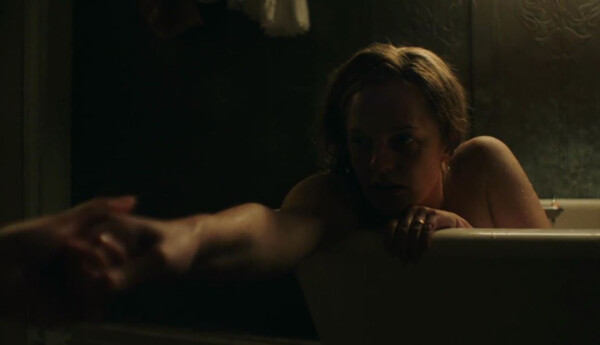
Image courtesy of Neon.
“Shirley” Starring Elizabeth Moss, Odessa Young, Michael Stuhlbarg and Logan Lerman. Directed by Josephine Decker. 107 minutes. Rated R.
Del’s take
“No live organism can continue for long to exist sanely under conditions of absolute reality; even larks and katydids are supposed, by some, to dream. Hill House, not sane, stood by itself against its hills, holding darkness within; it had stood so for eighty years and might stand for eighty more. Within, walls continued upright, bricks met neatly, floors were firm, and doors were sensibly shut; silence lay steadily against the wood and stone of Hill House, and whatever walked there, walked alone.”
Thus begins “The Haunting of Hill House,” a perfect novel befitting that perfect paragraph, and now blessed by a perfect dramatic rendition of the author’s life, “Shirley,” both an elegant and quixotic peek behind the curtain enshrouding horror writer Shirley Jackson.
Yet “Shirley” is not so much about Jackson as how she is perceived through the eyes of the callow wife of an instructor student who has come to Bennington College, Vermont, to learn how to be a literature professor. The young couple take room and board with Jackson and her husband, Stanley Edgar Hyman, an established professor at the college, and it is from that launching point we discover the people, and the story, and the frailties of intellect and ego, especially as they are coupled with eccentric, seemingly frail yet ultimately powerful collective of personalities.
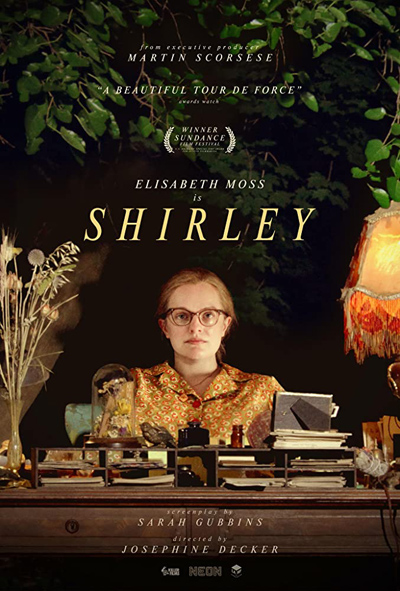
The physical structure of the movie is as dingbatty as its subject material, flitting from reality to flashback to daydream and wish-fulfillment – muzzy, out-of-focus sequences that provide insight into the thought processes of their selectively sighted muse. Likewise for the score, which flicks from folksy twang tunes with hidden stories to slithery, slinky dream themes suggestive of everything, from the narcotic haze from which Jackson reputedly penned her stories to her repressed lust for Rose, the female half of their tenant couple.
“Shirley” threatens to become “Who’s Afraid of Virginia Woolf” but backs away and wraps itself in something entirely different. Where it does resemble “Woolf” is in its quartet of actors and the quality of their performances. Elizabeth Moss is just stunning as Jackson, and if she isn’t rewarded with some kind of statuary, well, there is no justice. Equally stunning is Odessa Young as Professor Nemser’s wife, who arrives in the story innocent and eager to please, and leaves it with a knowing look and tic. Michael Stuhlbarg, who we last saw in “Call Me By Your Name,” is perfect as Jackson’s amoral husband, who is jealous of her talent and sets her up to fail, the covetous embodiment of the bromide, “Those who can’t do, teach.” Logan Lerman has the least screen time of the four but does a creditable job as the student professor who embraces the college monde a little too enthusiastically.
“Shirley” is for literature fans and movie fans, which means its audience will consist of a quiet few, those people against whom the silence lays steadily, as they walk, alone.
I rate it an A.
Del Stone Jr. is a former journalist and author.

Benson Kua
Photo courtesy of Benson Kua of flickr.
—
I am a lonely, miserable old man, with no reason to get up in the morning. I am alone now. I have always been alone, and I will always be alone.
Would you like to know why?
It is partly my own fault. I have always played it safe. I have never risked happiness. Small, safe steps has been my coda for as long as I can remember.
But it is partly because I have never, EVER been able to be the person I really am. I have always tried to be somebody else. The world required that I be somebody else, and for most of my life, I have been that person.
I did it because I was afraid – afraid I might be told I could not live in this house, or that neighborhood, or among those people.
I did it because I was afraid I would lose my job, that I would end up on the streets, penniless, another faceless person holding a sign at a street corner.
I did it out of a real fear for my safety. I have never been a fighter – or a lover, for that matter. I have always tried to slide by without drawing too much attention, an odd contradiction for somebody who is, or at least was, a public figure.
I did it primarily to spare my family the SHAME of having to live in a community that knew one of its members was a homosexual. Because that’s what our culture does to lesbians and gays, both overtly and covertly. It tells homosexuals that they are damaged goods – that they are defective, morally deficient … that they are unacceptable.
I did not want to subject my family to the harassment, the exclusion, the subtle whispering and the tsking and the million other ways our culture punishes anybody who is different, and anybody who happens to care about those different people.
So I have lived alone, and yes, it has bent me.
I have never known the joys of family, or companionship, or any of those things everybody else takes for granted. What I have known is coming home to an empty house every night. Enduring the withering hatred and aggression directed at people like me. Just trying to make it through the day without being ridiculed, beaten up or murdered.
Now that I am old, and nobody wants me, I have that and worse to look forward to.
Times have changed, but in many ways times have not changed. Some of things are still there – like racism, sexism, homophobia, and all the other “isms” and “obias” we haven’t grown out of.
And that’s why, when I see somebody trying to take back the meager gains that have been made over the past decade, I become angry. It’s not fair. It’s not right.
I should have told the world to go to hell and do what was best for me, but I didn’t, and now I’m stuck with this life which I cannot change.
I don’t want special treatment. I just want to have the same rights as everybody else.
And I don’t want to feel ashamed of being me.
—
Author’s note: Contact me at [email protected]. To read more of my opinion and humor pieces, visit delstonejr.com . I also write fiction – horror, science fiction and contemporary fantasy. If you’re a fan of such genres please check out my Amazon author’s page. Print and e-books are both available, and remember: You don’t need a Kindle device to read a Kindle e-book. Simply download the free Kindle app for your smart phone or tablet.
Video